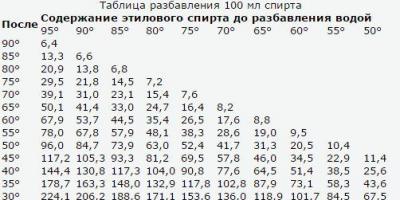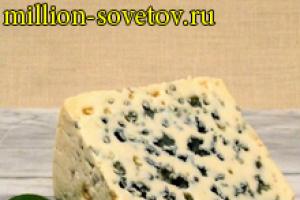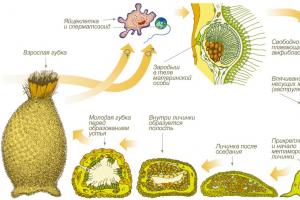Ceramics and utensils are an important part kitchen interior and their appearance actually makes a big difference in shaping your mood. Agree, breakfast will be much nicer if it is served in beautiful painted plates or cups.
Let's look at a few master classes for beginners that will help you use acrylic paints to transform your ordinary plain plates into small works of art with your own hands.
We will look at 3 main techniques for painting ceramics with acrylic: plates, cups and mugs using a stencil, as well as beautiful combination marker and paint.
We talked about it in this article!
How to hang 6 ways
- Once you have finished using the ceramic marker, I say cover it with a lid, even if it’s a short break from work. The tip may become clogged, but this can be avoided.
- Markers should be stored horizontally.
- It is important to put place the dishes in an unheated oven and heat them up, when she's already there. Otherwise, it may crack due to a sudden temperature change.
- Acrylic translucent paints, so they are best used on white or light-colored porcelain.
- If you want the paint to become less transparent, mix it with white.
Acrylic paint is resistant to washing (both manual and dishwasher) and microwave oven.
Please note that this paint is non-toxic. However, we do not recommend using it on surfaces that come into direct contact with food.
Master class No. 1: painting with black acrylic on a white plate
For this master class you will not need a lot of acrylic paints, just one color is enough. But ceramics painted in this way will not look any less impressive.

Materials:
- cups, ceramic plates, saucers (it is best to use porcelain or earthenware),
- tassel,
- black acrylic paint Pebeo Porcelaine 150 (or similar),
- damp cloth or towel.

Painting technology: 
- At first practice drawing on paper so as not to edit later once again on the dishes. But if there is a mistake on the dishes, it can be corrected with a damp cloth.
- Apply the design to the dishes. These could be flowers, stars, polka dots, small lines, or anything else that comes to your mind.
- Translucent paint, so for a clearer pattern, apply more than one coat.
- Leave dry for 24 hours.
- After this time, place place the dishes in a cool oven, set the temperature to 150° C. When the oven has warmed up to the set temperature, leave to bake.
- When the time is up, turn off the oven and let the dishes cool before removing.
- The result is beautiful dishes that only you have!



Master class No. 2: painting mugs and cups with acrylic paint
A fairly simple drawing will be used here, which does not require special artistic skills, so all you need is desire, materials and a little time.

Materials:
- white cup (mug) and saucer (ceramic or porcelain),
- marker Pebeo Porcelaine 150,
- several colors of acrylic paints (blue, sapphire, white, rainbow colors),
- one or two brushes,
- palette for mixing paints (you can use a plate),
- several cotton swabs (to correct mistakes),
- alcohol or glass cleaner, a regular kitchen stove.

Painting technology:
- First you need alcohol or window cleaner Clean ceramics and dishes from fingerprints or grease.
- We draw raindrops on the cup and saucer (except for the center of the saucer where the cup is placed), that is, their outlines. Draw a rainbow in the center of the saucer.
- Thus, it turns out that when the cup is on the saucer, the rainbow will not be visible, but when the cup is lifted from the saucer for tea, there will be a pleasant little surprise, rainbow in the literal and figurative sense of the word. Remember that the paint dries in 5-10 seconds.

TIP: If you have never used a marker before, you need to make the paint start to flow out of it. To do this, you need to shake it for about 30 seconds, and then press the tip onto a sheet of paper until the paint begins to flow. Once the paint has gone, you can start painting.
- Use a medium sized brush to paint the raindrops. Use blue paint. You can paint right away with the paint in the bottle, or you can add a little water so that the color is not so saturated. Do not shake the paint, this may create bubbles which will reduce the quality of the painting.


If you have gone a little beyond the contours and the paint has not yet dried, this can be corrected with a cotton swab or napkin. If the paint has already dried, first moisten a cotton swab with alcohol, and only then correct the mistake. If you made a big mistake when drawing and you want to start over, then wash the dishes under warm water or wipe with alcohol and let it dry thoroughly before starting to paint again.

- These paints mix well with each other, so you can paint some of the droplets with blue, then mix with sapphire and paint the rest. You can paint some of them with just paint, or often with paint mixed with water.
- It is important to wash and dry your brush well when switching to each new paint color.


- After you finish drawing the raindrops, move on to the rainbow. To do this, use a very thin brush so that the design is neat and does not go beyond the contours.
- remember, that green color can be obtained by mixing yellow and blue, and orange by mixing red and yellow.
- The drawing is already finished, but this dish is not ready for use yet. Leave to dry for 24 hours.
- After this time, place the dishes in a cool oven, set the temperature to 150° C. When the oven warms up to the set temperature, set the timer for 30 minutes and leave to bake. When the time is up, turn off the oven and let the dishes cool before removing.
- That's it now. You can enjoy your tea!

In general, with the help of these same tools you can draw any other drawing that appears in your imagination.

Master class No. 3: Painting a plate using a stencil
If you are worried that you won’t be able to immediately draw something on a plate, then a stencil can help you. It is also useful if you want to make a set of dishes from several identical plates or cups, then a stencil will help save time and achieve identity.

There is one trick worth knowing about this method: the stencil must be removed before the paint begins to dry, since it can then be removed with part of the paint.
Materials:
- porcelain, ceramic plates or even paper ones,
- acrylic paint,
- stationery knife,
- contact paper for stencil,
- brushes,
- oven.

Manufacturing stages:
- You can draw the stencils yourself or you can take one already ready-made drawings and print them out on contact paper.
- Place patterned contact paper on a plate.
- Carefully cut out the design with a utility knife.
- Using a brush, apply paint to the plate inside the stencil. If you mixed paints of different colors, make sure you get enough paint for all the plates so that they are all the same.


- Leave to dry for 24 hours.
- After this time, place the dishes in a cool oven, set the temperature to 150° C.
- When the oven reaches the set temperature, set the timer for 30 minutes and leave to bake. When the time is up, turn off the oven and let the dishes cool before removing.


The set of dishes is ready!
All dishes painted with these paints can be used for food. But it can also be used in room decoration. Either way, she's beautiful and unique!
Ideas for painting ceramics
Below are some ideas and designs for ceramic tableware decor and inspiration. Such plates self made- this is a birthday or Valentine's Day.












Stencils for painting
The easiest way to paint is, of course, a stencil. If you really don’t know how to draw or don’t like to draw, take a ready-made drawing, print it out, cut it out and attach it to a plate with tape. Paint it in the desired color.
Here are the simplest and most popular stencils for plates.
Another selection of themed coloring pages. This time the topic is dishes. The ability to generalize, find common features, and select a word-term that denotes a whole group of objects is a very difficult exercise for children.
Another selection of themed coloring pages. This time the topic is dishes. The ability to generalize, find common features, and select a word-term that denotes a whole group of objects is a very difficult exercise for children. Why is a cup, a bowl, a plate, and even a frying pan with a pot - all utensils? Are a knife, fork and spoon dishes or cutlery?
When coloring pictures of dishes, the child does not just mindlessly move the pencil, he mentally answers dozens of questions: what is this or that device made of, how to use it, what does it serve, what other types of dishes can be used with it, and so on, etc.
You can not just print out pictures and give them to your child, but arrange a whole game. Make a riddle, and let the child look for the answer among the pictures for coloring.
Here's an example:
You can listen to how the dishes sound. The glass tumbler rings loudly. And if you pour a little water, the tone changes. Experiment with pharaoh and earthenware cups, saucers, and plates.
|
|
|
|
|
|
|
|
|
|
|
|
Here are a few more pictures and riddles for them.
|
I'm puffing, puffing, I don't want to get warm anymore. The lid rang loudly: “Drink tea, the water has boiled!” (Kettle) |
Teapot girlfriend Has two ears He cooks porridge and soup for Yulia. And her name is... (Castle) |
There will be delicious food With a golden crust, If you use... That's right, with a frying pan! |
|
|
||
|
|
||
|
|
||
|
I take her by the hand, I pour tea into it. Drink - it's sweet and hot, If you want, cool it in a saucer. (Cup). |
There's a button on the head There is a sieve in the nose, One hand Yes, and the one on the back. (Teapot) |
I was born in the earth Tempered in fire. |
|
There are a lot of riddles about dishes, try to choose themed riddles for these pictures for coloring. If you need children's dishes, go to the website http://lilibon.ru/category/posuda/. The Lilibon online store presents only the best products for children. There you will find widest choice children's dishes for every taste.
|
||
Pictures for games and activities with children on the topic “Dishes”. As well as poems about dishes and tasks in pictures.
Pictures of dishes for games and activities with preschool children.
And today I will share with you my poem for the development of children’s speech “Dispute of dishes” and pictures of dishes that can be used in speech classes in kindergarten, at a children’s center or at home. I composed this poem specifically for my speech classes with children.
Poem in pictures “Dispute of dishes”.
For young children, a poem in pictures will help them quickly remember the names of different utensils. And the pictures will help you learn to find common and different things in different objects. Children will get acquainted with a general word - the concept of “dishes”, learn about its purpose and diversity.
And with older preschoolers you can play differently - after reading the poem, each player chooses what kind of dishware they will use. And on behalf of this object, he talks about himself (what he is made of, what parts he has, what he likes and dislikes, what his character is and why he considers himself the most important to people).







Tasks in pictures on the topic “Dishes”
In these tasks, the child needs to compare two objects with the same purpose, identify the common and the different. And identify the main essential feature - the purpose of the item (for example, a sugar bowl is needed to store sugar). After all, this is why the sugar bowl has a bottom (so that it stands well on the table), a lid (so that the sugar in it is always clean), and a handle on the lid (to make it convenient to open and close the lid and take sugar). A sugar bowl may have different designs and patterns, it may have handles, it may be porcelain or glass, but this still does not make it a coffee pot or candy bowl. Because it has a different purpose.
Task for children: The task of coming up with your own sugar bowl and candy bowl for a fairy-tale character (for example, Carlson, who really loves sweets) will help the child show creativity and consolidate his understanding of these objects. After all, when inventing your own item, you need to take into account its features so that the item turns out to be both convenient and beautiful. Children 3-4 years old can be given a silhouette of a sugar bowl to decorate and draw an ornament, and older children 5-6 years old will be happy to play designer and come up with a sugar bowl of the future.



Download pictures of dishes for free
You can download all pictures of dishes from this article in good resolution and high quality for free in our VKontakte group “Child development from birth to school” (in the “Documents” group section under the group video) or from this link
Games and pictures with dishes - for kindergarten A great opportunity to learn the names of various objects with children kitchen utensils, learn to distribute them according to the method of application and the material from which they are made.
Knowledge of utensils and the ability to handle them is one of the main requirements for graduates of preparatory groups.
In a kindergarten setting it is more convenient to work with children on this topic. Dishes for children are quite attractive and interesting things, so they are easily involved in the process of learning their names. It will be useful for children who can read to work with signed pictures - this way they will be able to visually remember the spelling of new or already familiar words.
To make the process take place in a playful way, it is better to cut the pictures into separate, fairly large cards. Then, taking out one card, invite the children to take a closer look at the object depicted on it and decide for what purposes it can be used. If one of the kids knows the name of the object, let them say it. If not, an adult introduces the name to the group.
























Pay attention to the details of the utensils, discuss what different kitchen utensils have in common and what they might be useful for. For example:
- Lid – many utensils have a lid. Helps retain heat inside, or protects the contents of the dishes from various debris, dust, etc. getting into it. Look among the cards for objects with a lid, remember their names, discuss their purpose.
- The handle is a part of many kitchen utensils. Allows you to hold an object and protect your hands from heat, allowing you to reach something without touching your hands. A frying pan, ladle, ladle, stewpan, colander and many other items have a handle (find them among the cards). Please note that the pan has two handles. For what? (So that you can hold a heavy container with both hands).
- Spout (near a teapot, jug). Helps pour liquid into a small container.
- Numerous holes (at a strainer, colander, slotted spoon). They allow you to filter, that is, separate large, solid particles from liquid and small particles.
- Every item that is a container has a bottom, that is, it is intended for temporary or permanent storage, preparation of food and liquid. Find all objects that have a bottom. In addition to the bottom, they also have walls, which can be of different heights, made of various materials. Look for the walls of the saucer (are there any?), the glass, or the pan.
When all the dishes have already been studied, pictures for children with names will help them remember the name of this or that item.
Be sure to discuss the materials from which kitchen utensils are made - glass, ceramics, metal. Group the pictures according to what material the object depicted in them is made of.
Then try to divide the pictures according to the role of the item into kitchens: intended for eating, for boiling or frying, for cooking.
If you have sets of utensils, you can finally work on the topic you’ve studied by working with toy kitchen utensils. You can advise the children to find the studied items at home, in the kitchen (with the consent of their mother). This will be a kind of homework, the results of which will be summarized the next day.
– a prerequisite for the successful development of a child and his social adaptation. Being well-versed in everyday life, he will feel self-confident and take an interest in everyday affairs and housekeeping.
Coloring books are a good way to master the topic of “dishes”; This is the best for kids accessible remedy after toy kitchen utensils.
Therefore, if toy dishes have not yet been purchased, coloring for children becomes the main means of exploring a world they have not yet known - the world of the kitchen. If you already have a toy dish, you can compare its objects with pictures, thereby developing the ability to establish spatial connections.
Coloring pages dedicated to the topic of “dishes” help children fill with color pictures in which the presented objects are already colored. This makes them more recognizable and allows you to decide on the right color. But if desired, the child may well use his own palette, creating color options that seem more attractive to him. If there is a toy dish, the child can use it as a coloring template.
You can use coloring for other purposes. For example, if you print some dishes on colored sheets, you will get wonderful templates for creating appliqués - just cut them out and glue them to the main background, creating an interesting composition. You can also use printouts on white sheets of paper, transferring them to colored sheets using carbon paper or tracing paper.























Colored cutlery
Another interesting option work with coloring - filling the contours of objects depicted on sheets with cereals, colored sand or pieces of colored paper. The contours of the dishes are quite wide, and the objects themselves are large. This allows them to be used for mastering grain sprinkling or mosaics.
You can create them from colored ones, working with which, the baby will better remember the names of various kitchen utensils. Children enjoy working with such didactic material. They readily group images according to certain characteristics and enjoy playing games like “name the object.”


















